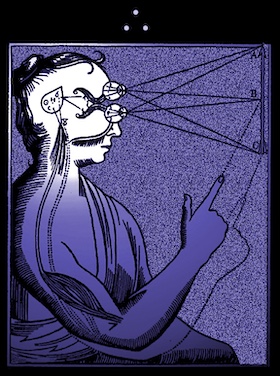Therefore began in a logic philosophy classroom in the late 1980's. Despite being an undergraduate philosophy major, I was awful at symbolic logic. Plus, I was convinced quite early that logic and reason were a form of artifice, a balm for the human mind in search of order, to have power over the chaos of experience. So, in irony, as a name for the recordings I was making I chose therefore. The three dots are the symbol for therefore in symbolic logic.
I was living in one of a series of garages, in and around a group of artists and musicians that would turn out to be the band Ten Hands. The first 4-track recordings, and my first song, were made in 1987 in an apartment in Denton, TX. Most of the gear I used in those years was borrowed. I fell for drum machines instantly, and found they were things I understood and could master. Like many such devices they presented possibilities within limitations. I spent endless hours with them, these small islands that were capable of generating continents. Once I got my own 4-track in 1988 I was off. For the next seven or eight years I learned everything I could about audio engineering, music production, and synthesis. Before that the only experience I had with audio equipment was cobbling together home and car stereo systems.
The first song was called “Nervous System” and featured a lot of erratic, staccato rhythms made on a borrowed drum machine. The main line was “This is my nervous system” and referred to the jumpy drum parts. Looking back on it, the song featured many elements I would use over and over and to this day: original drum machine sounds and custom patterns, guitar textured and soloing, and spoken word. The song featured the first of several reenacted phone conversations.
Another early song was “therefore girlfriend” which was recorded with guitars and voice to 4-track. This one was recorded as quietly as possible while my girlfriend slept in the next room, so the guitars were directly in to the recorder with no amplifier or speaker. For effects, I used backward recording and speed variations. I also discovered that “therefore” backward sounds like “girlfriend." It seemed to fit.
A few years later I added synthesizers to the process, and they were love at first sound. Most of my favorite music featured them, and they were, at the time, the new instrument with the promise of creating new worlds of sound.
So early therefore was about recording, inspired by the music I was listening to at the time: Eno, Bowie, Gabriel, Talking Heads, Laurie Anderson, electric Miles Davis, art rock and electric Jazz. Expressive, organic electronic sounds with complex rhythmic elements with poetic, artful, smart words and great performances were what I was interested in. Bowie’s “Always Crashing In The Same Car” is maybe the pinnacle of this.
I played guitar obsessively then, inspired by Robert Fripp, Adrian Belew, Andy Summers, John Scofield, John McLaughlin, and others. Anyone who wasn’t making the traditional rock and jazz sounds. If I wasn't going to be a visual artist I would be a guitarist.
The first cassette was mostly a collection of fragments and noises. After, I would work to make eight to ten songs on drum machine. When I left for graduate school in Claremont, California I would lose the borrowed drum machine so I programmed dozens of patterns and recorded them to cassette for future recordings. I used those patterns all during the next two years in Claremont until I managed to use student loan money to buy a used Alesis HR-16.
In Claremont I lived much of the time in the art building on an elevated 4x8 piece of plywood. There I slept and made recordings with my cat and 13” television. Though it was art school I spent the majority of the time making recordings for installations and cassette releases. The rest was spent on VHS video art and roaming the city and surrounding desert.


